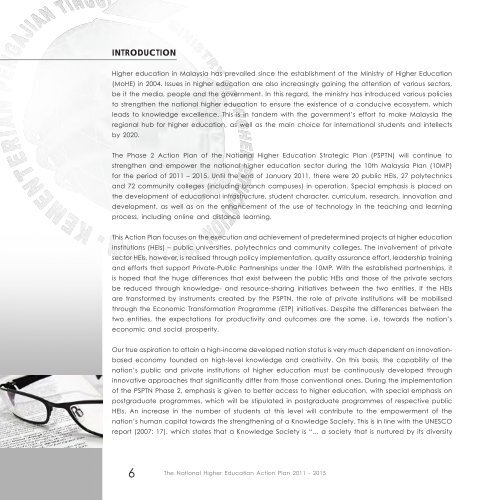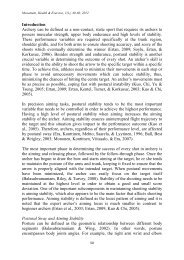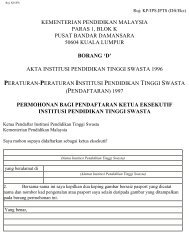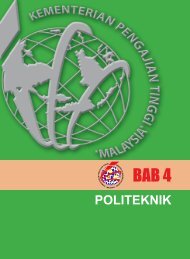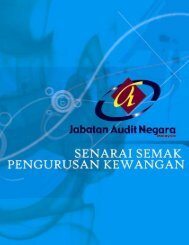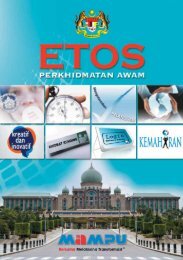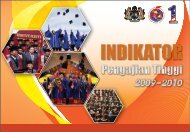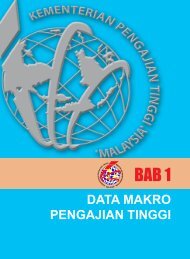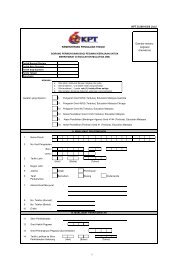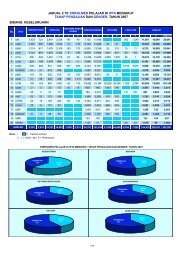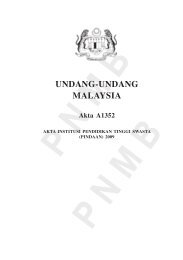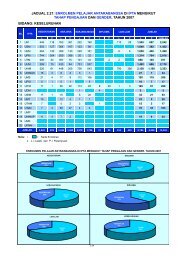STRATEGIC PLAN - Kementerian Pengajian Tinggi
STRATEGIC PLAN - Kementerian Pengajian Tinggi
STRATEGIC PLAN - Kementerian Pengajian Tinggi
- No tags were found...
Create successful ePaper yourself
Turn your PDF publications into a flip-book with our unique Google optimized e-Paper software.
INTRODUCTIONHigher education in Malaysia has prevailed since the establishment of the Ministry of Higher Education(MoHE) in 2004. Issues in higher education are also increasingly gaining the attention of various sectors,be it the media, people and the government. In this regard, the ministry has introduced various policiesto strengthen the national higher education to ensure the existence of a conducive ecosystem, whichleads to knowledge excellence. This is in tandem with the government’s effort to make Malaysia theregional hub for higher education, as well as the main choice for international students and intellectsby 2020.The Phase 2 Action Plan of the National Higher Education Strategic Plan (PSPTN) will continue tostrengthen and empower the national higher education sector during the 10th Malaysia Plan (10MP)for the period of 2011 – 2015. Until the end of January 2011, there were 20 public HEIs, 27 polytechnicsand 72 community colleges (including branch campuses) in operation. Special emphasis is placed onthe development of educational infrastructure, student character, curriculum, research, innovation anddevelopment, as well as on the enhancement of the use of technology in the teaching and learningprocess, including online and distance learning.This Action Plan focuses on the execution and achievement of predetermined projects at higher educationinstitutions (HEIs) – public universities, polytechnics and community colleges. The involvement of privatesector HEIs, however, is realised through policy implementation, quality assurance effort, leadership trainingand efforts that support Private-Public Partnerships under the 10MP. With the established partnerships, itis hoped that the huge differences that exist between the public HEIs and those of the private sectorsbe reduced through knowledge- and resource-sharing initiatives between the two entities. If the HEIsare transformed by instruments created by the PSPTN, the role of private institutions will be mobilisedthrough the Economic Transformation Programme (ETP) initiatives. Despite the differences between thetwo entities, the expectations for productivity and outcomes are the same, i.e. towards the nation’seconomic and social prosperity.Our true aspiration to attain a high-income developed nation status is very much dependent on innovationbasedeconomy founded on high-level knowledge and creativity. On this basis, the capability of thenation’s public and private institutions of higher education must be continuously developed throughinnovative approaches that significantly differ from those conventional ones. During the implementationof the PSPTN Phase 2, emphasis is given to better access to higher education, with special emphasis onpostgraduate programmes, which will be stipulated in postgraduate programmes of respective publicHEIs. An increase in the number of students at this level will contribute to the empowerment of thenation’s human capital towards the strengthening of a Knowledge Society. This is in line with the UNESCOreport (2007: 17), which states that a Knowledge Society is “… a society that is nurtured by its diversity6The National Higher Education Action Plan 2011 - 2015


